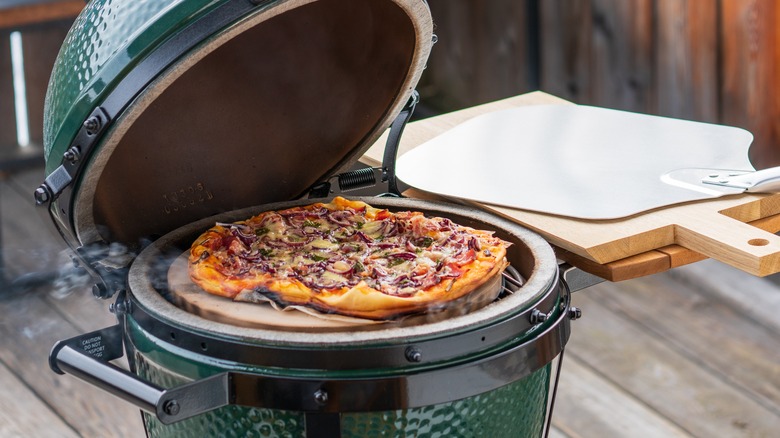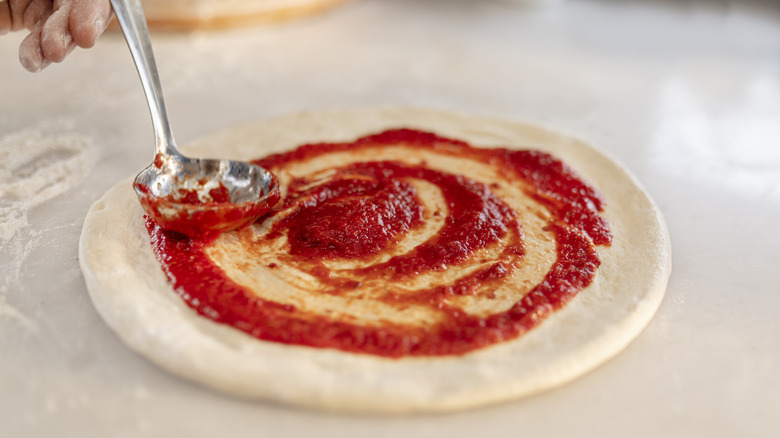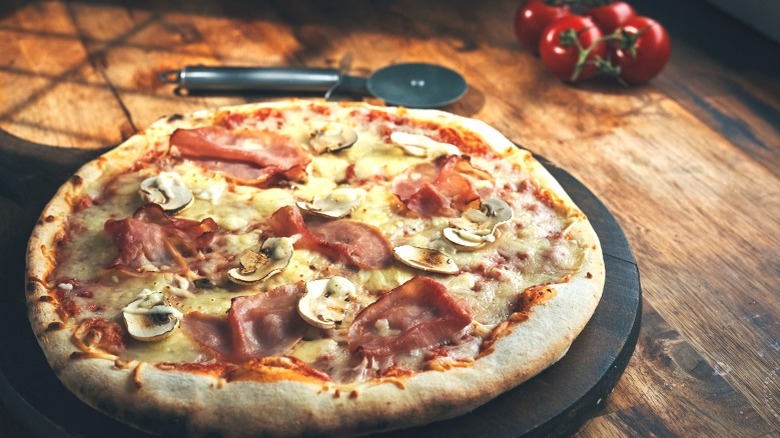The Key To Cooking Pizza On The Grill Is All About The Crust
Beyond installing a professional pizza oven — which requires finesse, like knowing which ingredients don't belong in there – using your grill to make pizza may be the best way to produce an outstanding pie at home, especially if you love a wood-fired flavor and bubbly, charred crust. A bonus is that you'll be keeping the heat outside of your kitchen, which indeed matters, especially in the summertime. But for excellent results, you can't treat the pizza as you would if you were baking it in an oven. The key is to grill one side only... at least, before you put your toppings on.
The natural inclination when grilling pizza might be to place everything — the sauce, cheese, meats, and veggies — right on top of the raw pizza dough and slide the whole thing onto your grill. However, it's much better to grill one side of your pizza dough just until it starts to brown, then move it to a board or large plate, grilled side up. Place your sauce, cheese, and toppings on and carefully slide the pizza back onto the grill, with the uncooked side of the dough facing the flames.
You'll then want to lower the heat and close or cover the grill, so that the heat will melt your cheese and warm your toppings without burning the dough. By the time everything is melted and hot, the bottom side of the crust should be nice and browned and perfectly crisp.
What not to do when grilling pizza
Why can't you just skip the extra steps and put a fully-assembled pie on the grill? First off, keeping the crust's shape could prove to be awkward and difficult, with raw dough drooping and toppings dropping off the grates. Plus, the side of the dough with the toppings may not cook through at all, and certainly won't have those glorious, chewy and crispy bits. Grilling both sides of the dough before piling on the toppings also isn't ideal, because by the time your cheese is melted and your veggies begin to char, the bottom of your crust may be a little too cooked (and potentially burnt). These would all be sad lessons to learn about homemade pizza.
By cooking one side of the dough first, it will become stable enough for you to take it off the grill with a spatula or tongs, without it ripping apart. Even once the toppings go on the grilled side and you place the pizza back onto the heat raw side-down, it should be strong enough to slide right back onto the grates. However, you still shouldn't go crazy with the toppings; overloading the top of the crust could make the pie too heavy, creating the potential for tears in the dough or the toppings not getting cooked enough.
Tips for a better grilled pizza
We grill a lot of pizza at my house; in fact, our grilled pizza count far exceeds our delivery or carryout count. Now, every grill is different with its own quirks and heat points, but I've found that our grill cooks pizza dough rather swiftly. With that being said, I recommend pre-cooking some toppings before they go on the dough.
Pepperoni, prosciutto, and of course, the cheese are fine to go on without precooking, but mushrooms, bell peppers, spinach, onions, and basically anything else that would take a bit of time to cook down on the stovetop is best cooked beforehand. If you place them raw on the pizza, they might not get very soft by the time your crust is done.
A gas grill has worked best for our pizzas, because it's easier to control the heat, but if you have a charcoal grill, consider using a pre-heated pizza stone. When you initially place your raw dough on the grill, it might puff up with large pockets of air. You can either pop them with a sharp knife or let them be. By the time you remove the crust from the grill and place your toppings on, the bubbles will mostly be deflated. Finally, soft, quick-melting cheeses work best, so classic shredded mozzarella, like the pizza pros' preferred brands, is perfect for grilled pizza. And go easy with the sauce so the crust doesn't get too soggy.


